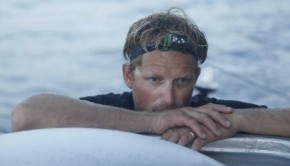Ocean Masters: Parked in the Med
Published on June 14th, 2014
(June 14, 2014) – Into the Mediterranean and, with the end tantalisingly close, frustration continues to reign supreme in the IMOCA Ocean Masters New York to Barcelona Race. Over the last 24 hours the boats have been dogged by everything from light wind to no wind and progress remained very slow as the leaders at midday were attempting to round Cabo de Palos, to the east of Cartagena.
Over the 24 hours leading up to 10:30 UTC, Hugo Boss had managed to cover a meagre 110.6 miles, equating to an average speed of 4.6 knots. But this was the high score compared to GAES which had sailed 92.7 miles (3.9 knots) and Team Neutrogena just 85.8 (3.6 knots).
To contrast this, the top 24 hour runs in this race occurred as the boats were reaching into the middle of a depression mid-Atlantic on 5th June. In the 24 hours leading up to 05:30 UTC that day, Hugo Boss recorded the highest 24 hour run of the race – 446.55 nautical miles at an average speed of 18.6 knots. This was 0.1 faster than Safran and 0.2 more than Team Neutrogena sailed around the same time.
While the brutal conditions the boat experienced on the approach to, or in, the Strait of Gibraltar earlier this week were physically demanding, and culminated in the injury of race-leading skipper Marc Guillemot on Safran, racing in light airs is no less challenging. For the crew it may be less dangerous and far less physical, but to sail well in this requires formidable concentration.
It is necessary to spot and steer to the slightest zephyr on the water, and to respond to the weakest puff of wind by trimming or hoisting a new sail, while the boat must be suitably ‘stacked’ with all the movable gear down below pulled forward as far as possible, to lift the yacht’s stern out of the water, reducing the drag of her hull through the water.
Race Director and experienced shorthanded ocean racer Jacques Caraes explains: “In light winds you have to concentrate a great deal because you can lose the little speed you have very quickly – so that requires huge attention. And because the wind is light and very shifty someone will have to steer all the time.
“For sure the crews must be tired. In fact you can get much more tired in light weather than in rough weather.”
On board Neutrogena this morning, Chilean co-skipper José Muñoz reported that they had just 5 knots of wind from the south and they were patiently waiting for better conditions.
“Last night we were looking for options to attack, by trying to do something different. We expected to sail faster but at the moment we are slower than Hugo Boss. “
At 11:00 Team Neutrogena had dropped back to 26 miles behind Hugo Boss. Meanwhile third placed GAES had still to reach Cato Gato and was 102 miles behind the race leader.
From on board the back marker Gerard Marin reported that they were experiencing 7 knots of wind from the due south this morning. He added: “Everything is okay on board. We had some electronic problems – the displays aren’t working very well. It doesn’t look like we are fighting for second place any more. We are just eager to finish.”
The remaining miles to Barcelona are going to be become yet more stressful, requiring the utmost adaptability from the crews. The wind is expected to build as the thermal sea breeze fills off the coast this afternoon. This evening the forecast has it going light again before the wind fills in with a vengeance after midnight when the boats are expected to find themselves once again crashing upwind in 25-30 knots from the north. But this too will be shortlived, with light winds returning to the course in the afternoon.
ETA for the first boat to finish in Barcelona is currently the evening of Sunday, 15th June, anytime from 2000 hrs to midnight – weather dependent.
Content by event media.
Background: The 3720 mile IMOCA Ocean Masters New York to Barcelona Race is a new doublehanded race for the Open 60 class. Five teams started from New York on June 1.










 We’ll keep your information safe.
We’ll keep your information safe.